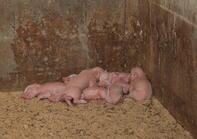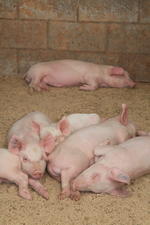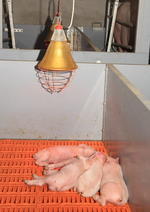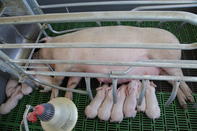Because of South Africa’s warm climatic conditions, cold stress in pigs is not as serious as in some cooler countries.

The winters, however, and especially winter nights, can nevertheless be really chilly in some parts of the country, so farmers in these areas need to take extra precautions to shelter their pigs during such times.
Piglets are especially vulnerable to cold stress since, unlike adult piglets, they have very little body fat to protect them from the cold, especially during the first forty-eight hours after they have been born. They will not thrive and most probably end up dead if they are not kept warm.
Signs of Stress

As with adult pigs, failure to keep piglets warm will result in the energy they generate from their food being used for heat generation instead of growth. So how do you know your pigs are suffering from cold stress?
According to Animal Agriculture at Washington State University, pigs suffering from cold stress will huddle together or lie with their feet tucked beneath them in an attempt to get warm. They may also shiver from the cold.
If the cold stress continues for more than a few days, the pigs will get skinny, grow poorly and develop long rough coats of hair. They may also suffer from diarrhoea.
Prevention

Providing comfortable temperatures during farrowing is easier said than done, since sows and piglets thrive at different temperature levels.
Sows are generally most comfortable at 16 to 25 degrees celsius, while piglets will thrive at temperatures as high as 32 degrees celsius. Sows that are getting too hot will start eating less and also produce less milk, which in turn will have a negative impact on piglet growth.
The piglets, however, need to be kept warm to grow well. In modern facilities, the room temperature will, therefore, be adapted to the requirements of the sows, while additional or spot heating is used to keep the piglets warm.
For accuracy, it is important to take the room temperature at the same level and also a few feet into the area where the piglets are kept.

Flooring is also strategically used to solve this problem, with sows usually lying on a floor made from cooler material than the area on which the piglets are kept.
The floor can be made from material ranging from wood to concrete, steel, plastic, fibreglass, cast iron and aluminium. Using bedding, such as straw or wood shavings, on the floor surface where the piglets are kept, will not only help to raise temperatures where the piglets are kept but also help to keep them comfortable.
The bedding should nevertheless, be frequently replaced or new bedding added to keep the piglets dry and clean. Piggeries should be well insulated, from the floors to the ceilings and the walls to prevent drafts. Some farmers use plastic curtains to close windows during cold and adverse climatic conditions.
By Glenneis Kriel